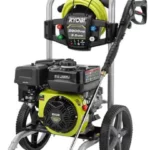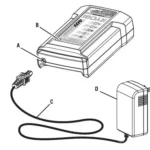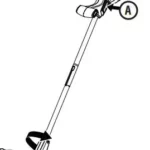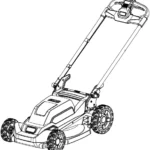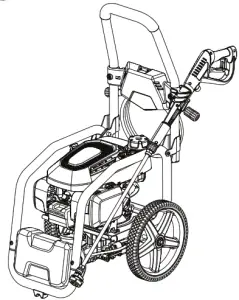

OPERATOR’S MANUAL
3300 PSI PRESSURE WASHER
RY803325
REGISTER YOUR TOOLS
http://register.ryobitools.com
1-800-525-2579
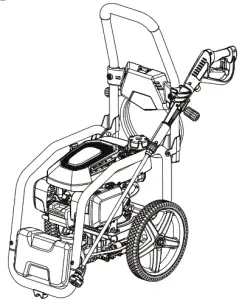
NOTICE![]()
Do not use E15 or E85 fuel in this product. It is a violation of federal law and will damage the unit and void your warranty. Only use unleaded gasoline containing up to 10% ethanol.
 WARNING: To reduce the risk of injury, the user must read and understand the operator’s manual before using this product.
WARNING: To reduce the risk of injury, the user must read and understand the operator’s manual before using this product.
SAVE THIS MANUAL FOR FUTURE REFERENCE
See this fold-out section for all the figures referenced in the operator’s manual.
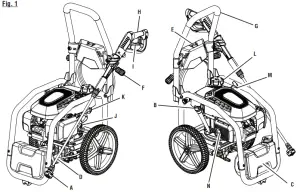
| A – 5-in-1 Change-over nozzle B – Oil cap/dipstick C – Soap tank D – Spray wand E – Hose storage F – High-pressure hose G – Handle |
H – Trigger handle I – Trigger with lockout J – Engine stop switch K – Fuel tank L – Fuel cap M- Starter grip and rope N – Muffler |
 A – Handle release knob
A – Handle release knob
B – Handle
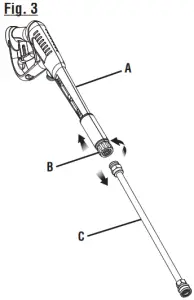 A – Trigger handle
A – Trigger handle
B – Connector
C – Spray wand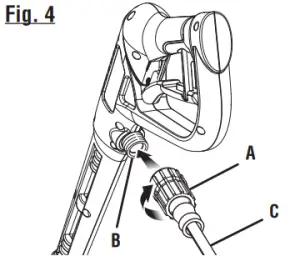
A – Collar
B – Inlet coupler
C – High-pressure hose
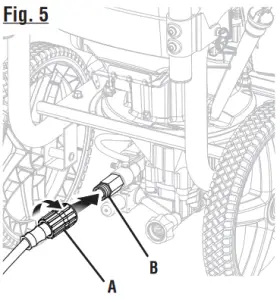
A – High-pressure hose
B – Collar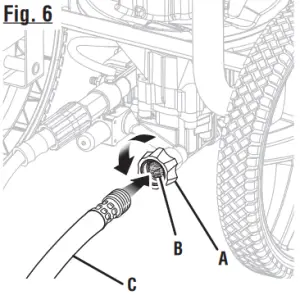 A – Water intake
A – Water intake
B – Screen
C – Garden hose
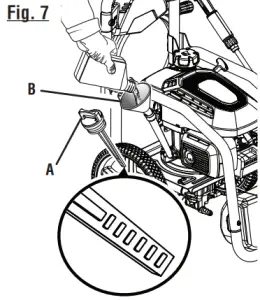 A – Oil cap/dipstick
A – Oil cap/dipstick
B – Funnel
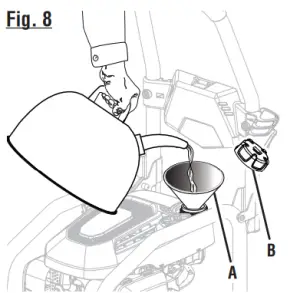
A – Funnel
B – Fuel cap
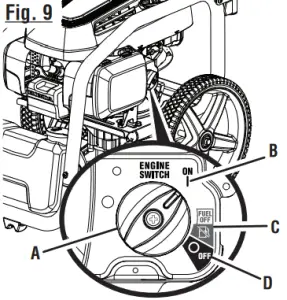
A – Engine stop switch
B – ON position
C – Fuel valve
D – OFF position
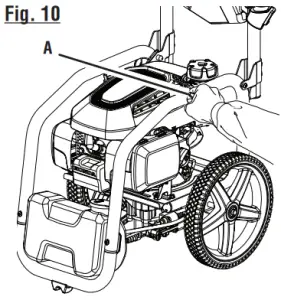 A – Starter grip and rope
A – Starter grip and rope
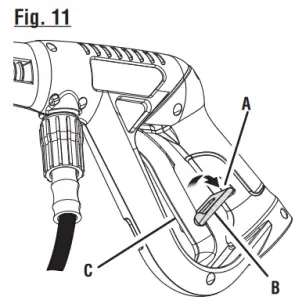 A – Slo
A – Slo
B – Lockout
C – Trigger
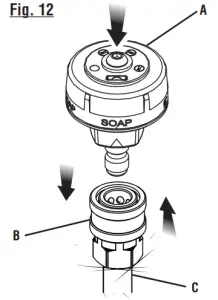
A – 5-in-1 Change-over nozzle
B – Quick-connect collar
C – Spray wand
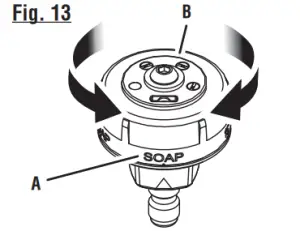 A – 5-in-1 Change-over nozzle
A – 5-in-1 Change-over nozzle
B – Spray selector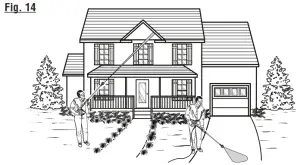
A – Long-range detergent [![]() ]
]
B – Short-range detergent [![]() ]
]

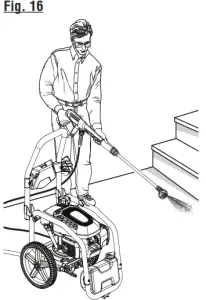
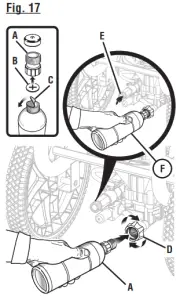
A – Threaded top
B – Rubber seal
C – Paper seal
D – Water intake
E – Pump outlet
F – Pump protector
TO MOVE THE PRESSURE WASHER
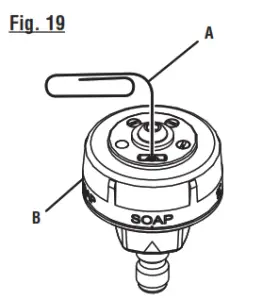 A – Paper clip
A – Paper clip
B – 5-in-1 Change-over nozzle
Fig. 20
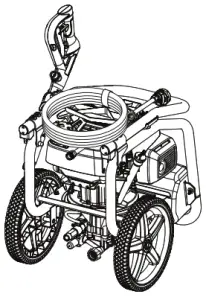 TO STORE THE MACHINE
TO STORE THE MACHINE
IMPORTANT SAFETY INSTRUCTIONS
 DANGER:
DANGER:
Risk of fire and serious burns: Never remove the fuel cap when the unit is running. Shut off the engine and allow the unit to cool for at least five minutes. Remove cap slowly.
 WARNING:
WARNING:
Read and understand all instructions. Failure to follow all instructions listed below may result in electric shock,
fire, and/or carbon monoxide poisoning which will cause death or serious personal injury.
READ ALL INSTRUCTIONS
- Know your tool. Read the operator’s manual carefully. Learn the machine’s applications and limitations as well as the specific potential hazards related to this tool.
- Keep guards in place and in working order. Never operate the tool with any guard or cover removed. Make
sure all guards are operating properly before each use. - Remove adjusting keys and wrenches. Form habit of checking to see that keys and adjusting wrenches are
removed from the tool before turning it on. - To reduce the risk of injury, keep children and visitors away. All visitors should wear safety glasses and be kept at a safe distance from the work area.
- Keep the area of operation clear of all persons, particularly small children, and pets.
- Do not start or operate the engine in a confined space, building, near open windows, or in other ventilated spaces where dangerous carbon monoxide fumes can collect. Carbon monoxide, a colorless, odorless, and extremely dangerous gas can cause unconsciousness or death.
- Use the right tool. Don’t force tools or attachments to do a job it was not designed for. Don’t use it for a purpose not intended.
- Dress properly. Wear long pants and long sleeves. Do not wear loose clothing, neckties, or jewelry. They can get caught and draw you into moving parts. Rubber gloves and nonskid footwear are recommended when working outdoors. Also wear protective hair covering to contain long hair.
- Do not operate the equipment while barefoot or when wearing sandals or similar lightweight footwear. Wear protective footwear that will protect your feet and improve your footing on slippery surfaces.
- Exercise caution to avoid slipping or falling.
- Always wear eye protection with side shields marked to comply with ANSI Z87.1. Following this rule will reduce the risk of serious personal injury.
- Don’t overreach or stand on a ladder, rooftop, or other unstable support. Keep proper footing and balance at all times.
- Use only recommended accessories. The use of improper accessories may cause a risk of injury.
- Follow the maintenance instructions specified in this manual.
- Check damaged parts. Before further use of the tool, a guard or other part that is damaged should be carefully checked to determine that it will operate properly and perform its intended function. Check for alignment of moving parts, binding of moving parts, breakage of parts, mounting, and any other conditions that may affect its operation. A guard or other part that is damaged must be properly repaired or replaced by a qualified service center to avoid the risk of personal injury.
- Never leave the tool running unattended. Turn the power off.
Don’t leave the tool until it comes to a complete stop. - Keep the engine free of grass, leaves, or grease to reduce the chance of a fire hazard.
- Keep the exhaust pipe free of foreign objects.
- Follow manufacturer’s recommendations for the safe loading, unloading, transport, and storage of the machine.
- Be thoroughly familiar with controls. Know how to stop the product and bleed pressure quickly.
- Keep the tool dry, clean, and free from lubricant and grease. Always use a clean cloth when cleaning. Never use brake fluids, gasoline, petroleum-based products, or any solvents to clean tools.
- Stay alert and exercise control. Watch what you are doing and use common sense. Do not operate the tool when you are tired. Do not rush.
- Do not operate the product while under the influence of drugs, alcohol, or any medication.
- Check the work area before each use. Remove all objects such as rocks, broken glass, nails, wire, or
string which can be thrown or become entangled in the machine. - Do not use the tool if the switch does not turn it off. Has the switch been replaced by a qualified service center?
- Before cleaning, repairing, or inspecting, shut off the engine and make certain all moving parts have stopped.
Disconnect the spark plug wire, and keep the wire away from the plug to prevent accidental starting. - Avoid dangerous environments. Don’t use it in damp or wet locations or expose it to rain. Keep work area well lit.
- Never use in an explosive atmosphere. Normal sparking of the motor could ignite fumes.
- Do not operate while smoking or near an open flame.
- Do not operate around dry brush, twigs, cloth rags, or other flammable materials.
- WARNING: Risk of injection or injury – Do not direct discharge stream at persons.
SPECIFIC SAFETY RULES
- Use caution when positioning the pressure washer for use. Warm air from the engine could cause discolored spots on the grass.
- Never direct a water stream toward people or pets, or any electrical device.
- Before starting any cleaning operation, close doors and windows. Clear the area to be cleaned of debris,
toys, outdoor furniture, or other objects that could create a hazard. - Never pick up or carry a machine while the engine is running.
- Never start the machine if ice has formed in any part of the equipment.
- Do not use acids, alkalines, solvents, flammable material, bleaches, or industrial grade solutions in this product. These products can cause physical injuries to the operator and irreversible damage to the machine.
- Always operate the machine on a level surface. If the engine is on an incline, it could seize due to improper lubrication (even at the maximum lubricant level).
- WARNING: High-pressure jets can be dangerous if subject to misuse. The jet must not be directed at persons, animals, electrical devices, or the machine itself.
- Hold the trigger handle securely with both hands. Expect the trigger handle to move when the trigger is pulled due to reaction forces.
Failure to do so could cause loss of control and injury to yourself and others. - Never attempt to make any adjustments while the engine (motor) is running (except where specifically recommended by the manufacturer).
- Protective covers must always cover rotating parts when the engine is running.
- Keep cooling air intake (starter grip and rope area) and muffler side of the engine at least 3 feet away from buildings, obstructions, and other combustible objects.
- Keep the engine away from flammables and other hazardous materials.
- Keep away from hot parts. The muffler, exhaust gases, and other engine parts become very hot. Do not touch the muffler or place any body parts in the path of hot exhaust gases, which can cause burns and other serious personal injuries.
- Do not touch the spark plug and ignition cable when starting and operating the engine.
- Check fuel hoses and joints for looseness and fuel leakage before each use.
- Check bolts and nuts for looseness before each use. A loose bolt or nut may cause serious engine problems.
- Always refuel outdoors. Never refuel indoors or in a poorly ventilated area.
- Never store the machine with fuel in the fuel tank inside a building where ignition sources
are present, such as hot water and space heaters, clothes dryers, and the like. - If the fuel tank has to be drained, do this outdoors into a container approved for gasoline and away from all ignition sources.
- To reduce the risk of fire and burn injury, handle fuel with care. It is highly flammable.
- Do not smoke while handling fuel.
- Add fuel before starting the engine. Never remove the cap of the fuel tank or add fuel while the engine is running or when the engine is hot.
- Loosen the fuel cap slowly to release pressure and to keep fuel from escaping around the cap.
- Replace all fuel tanks and container caps securely.
- Wipe spilled fuel from the unit. Move 30 feet away from the refueling site before starting the engine.
- If fuel is spilled, do not attempt to start the engine, but move the machine away from the area of spillage and avoid creating any source of ignition until fuel vapors have dissipated.
- Never attempt to burn off spilled fuel under any circumstances.
- Before storing, allow the pressure washer to cool for30 minutes and drain fuel from the unit.
- Store fuel in a cool, well-ventilated area, safely away from spark and/or flame-producing equipment.
- Store fuel in containers specifically designed for this purpose.
- Empty fuel tank and restrain the unit from moving before transporting to a vehicle.
- When servicing use only recommended or equivalent replacement parts. Use of any other parts may create a hazard or cause product damage.
- ONLY use cold water.
- Make sure minimum clearance of 3 feet is maintained from combustible materials.
- Never spray close to the surface to be cleaned as you can damage the surface.
- After stopping the engine, always pull the trigger on the trigger handle to relieve stored pressure in the high-pressure hose. Failure to do so could result in serious personal injury.
- For outdoor use only.
- Ensure the high-pressure hose is properly connected before using the product.
- Save these instructions. Refer to them frequently and use them to instruct other users. If you loan someone this tool, loan them these instructions also.
SYMBOLS
| The following signal words and meanings are intended to explain the levels of risk associated with this product. | ||
| SYMBOL | SIGNAL | MEANING |
 |
DANGER: | Indicates a hazardous situation, which, if not avoided, will result in death or serious injury. |
 |
WARNING: | Indicates a hazardous situation, which, if not avoided, could result in death or serious injury. |
 |
CAUTION: | Indicates a hazardous situation, that, if not avoided, may result in minor or moderate injury. |
| NOTICE: | (Without Safety Alert Symbol) Indicates information considered important, but not related to a potential injury (e.g. messages relating to property damage). | |
| Some of the following symbols may be used on this product. Please study them and learn their meaning for the safe operation of this product. | ||
| SYMBOL | NAME | EXPLANATION |
 |
Safety Alert | Indicates a potential personal injury hazard. |
| Read Operator’s Manual | To reduce the risk of injury, users must read and understand the operator’s manual before using this product. | |
| Eye Protection | Always wear eye protection with side shields marked to comply with ANSI Z87.1. | |
| Wet Conditions Alert | Do not expose to rain or use in damp locations, and never direct a water stream toward any electrical device. | |
| Hot Surface and Exhaust Gases | To reduce the risk of injury or damage, avoid contact with any hot surface and do not place any body parts in the path of hot exhaust gases. | |
| Risk of Injections | To reduce the risk of injection or injury, never direct a water stream towards people or pets or place any body part in the stream. Leaking hoses and fittings are also capable of causing injection injury. Do not hold hoses or fittings. | |
| Risk of Explosion | Do not spray flammable liquids. Flammable liquids, fuel, and their vapors are explosive and can cause severe burns or death. | |
| Risk of Fire | Do not add fuel when the product is operating or still hot. Fire can cause severe burns or death. | |
| Some of the following symbols may be used on this product. Please study them and learn their meaning for the safe operation of this product. | ||
| SYMBOL | NAME | EXPLANATION |
| Toxic Fumes | Running this product indoors can result in death due to carbon monoxide, a poison gas you cannot see or smell. Never operate indoors, even if windows and doors are open. Only use outdoors and at least 20 feet away from windows, doors, and openings or vents. | |
| Kickback | To reduce the risk of injury from kickback, hold the spray wand securely with both hands when the machine is on. | |
| Electric Shock | Do not use near electric power lines or receptacle outlets. | |
| Chemical Burns | To reduce the risk of injury or damage, DO NOT USE ACIDS, ALKALINES, BLEACHES, SOLVENTS, FLAMMABLE MATERIAL, OR INDUSTRIAL GRADE SOLUTIONS in this product. | |
FEATURES
PRODUCT SPECIFICATIONS
Fuel Tank Capacity ……………………………………………………………………………………………………………….0.24 gal.
Honda GCV200 engine………………………………………………………………………………………………………..202cc
Maximum Pounds Per Square Inch Pressure* ………………………………………………………………….. 3300 psi
Maximum Gallons Per Minute* …………………………………………………………………………………………2.5 GPM
Maximum Inlet Water Temperature …………………………………………………………………………………..104˚F
*Max. rating determined by PWMA Standard 101
KNOW YOUR PRESSURE WASHER
See Figure 1.
The safe use of this product requires an understanding of the information on the tool and in this operator’s manual as well as a knowledge of the project you are attempting. Before the use of this product, familiarize yourself with all operating features and safety rules.
5-IN-1 CHANGE-OVER NOZZLE
The 5-in-1 Change-over Nozzle makes it easy to change spray patterns.
AUTOMATIC CHOKE SYSTEM
The automatic choke system allows the engine to start easily whether cold or hot and is ready to use immediately.
AUTOMATIC SOAP INJECTION SYSTEM
Pour pressure washer detergent into the soap tank to apply detergent quickly and easily to your cleaning project. Use of the soap nozzle will activate the soap injector at a 20:1 dilution ratio.
FUEL TANK
This fuel tank has a maximum capacity of 0.24 gal. Use unleaded automotive gasoline in the engine.
HONDA GCV200 ENGINE
This Honda engine enables the pressure washer to achieve 3,300 psi (pounds per square inch) at a rate of 2.5 GPM ( gallons per minute). Please read the engine manual included with this product.
HOSE STORAGE
Once the high-pressure hose is rolled, hang it on the back of the machine using the stretch strap to secure in place.
IDLE DOWN
The engine idle speed is automatically reduced when the trigger is released. This feature increases fuel efficiency, reduces the noise level, and decreases wear and tear over the life of the pressure washer.
ON/OFF SWITCH
The on/off switch is used in combination with the starter grip and rope to start the engine. It is also used to turn the engine off.
STARTER GRIP AND ROPE
The starter grip and rope is pulled to start the machine.
THERMAL RELIEF VALVE
This pump feature will prevent water temperatures from reaching harmful levels by releasing a small amount of
water. Once the water has drained, the thermal relief valve will reset itself.
TRIGGER HANDLE
The trigger handle has a gripping surface that provides added control of the spray wand and helps reduce fatigue.
TRIGGER WITH LOCKOUT
Pulling the trigger releases a stream of water for high-pressure cleaning. The lock-out provides protection against unauthorized use.
ASSEMBLY
UNPACKING
This product requires assembly.
• Carefully remove the product and any accessories from the box. Make sure that all items listed in the Packing
List is included.
NOTE: This tool is heavy. To avoid back injury, lift with your legs, not your back, and get help when needed.
WARNING:
Do not use this product if any parts in the Packing List are already assembled to your product when you unpack it. Parts on this list are not assembled to the product by the manufacturer and require custom installation. Use of a product that may have been improperly assembled could result in serious personal injury.
- Inspect the tool carefully to make sure no breakage or damage occurred during shipping.
- Do not discard the packing material until you have carefully inspected and satisfactorily operated the
tool. - If any parts are damaged or missing, please call 1-800-525-2579 for assistance.
PACKING LIST
Pressure Washer
50 ft. High-Pressure Hose
Trigger Handle
Spray Wand
5-in-1 Change-over Nozzle
4-Cycle Engine Lubricant (SAE 30 or SAE 10W30)
Disposable Funnel
Operator’s Manual
 WARNING:
WARNING:
If any parts are damaged or missing do not operate this product until the parts are replaced. Use of this product with damaged or missing parts could result in serious personal injury.
 WARNING:
WARNING:
Do not attempt to modify this product or create accessories not recommended for use with this product. Any such alteration or modification is misused and could result in a hazardous condition leading to possible serious personal injury.
 WARNING:
WARNING:
To prevent accidental starting that could cause serious personal injury, always disconnect the engine spark plug
the wire from the spark plug when assembling parts.
RAISING AND LOWERING THE HANDLE
See Figure 2.
- To raise the handle: pull the handle up until the handle release knob snaps through the locking hole to secure the handle in place.
- To lower the handle: pull the handle release knob out then lower the handle to the position shown in figure 2.
CONNECTING THE SPRAY WAND TO THE TRIGGER HANDLE
See Figure 3.
- Place the threaded end of the spray wand in the connector on the end of the trigger handle.
- Fully tighten the connector to secure the spray wand in place.
CONNECTING THE HIGH-PRESSURE HOSE TO THE TRIGGER HANDLE
See Figure 4.
- Screw the collar on the high-pressure hose into the trigger handle inlet coupler by turning the hose collar clockwise.
Tighten securely.
NOTE: Be careful to avoid cross-threading, which can cause the trigger handle to leak during use. - Pull-on the hose to be certain it is properly secured.
CONNECTING THE HIGH-PRESSURE HOSE
TO THE PUMP
See Figure 5.
- Completely uncoil and straighten the high-pressure hose to prevent kinks.
NOTE: See Using the High-Pressure Hose in Operation for more information about using the high-pressure hose. - Align the collar on the hose to the threaded outlet on the pump.
- Install the high-pressure hose collar onto the threaded outlet.
- Turn the collar clockwise to tighten the hose securely to the pump.
NOTE: Be careful to avoid cross-threading, which can cause the hose to leak during use. - Pull-on the hose to be certain it is properly secured.
CONNECTING THE GARDEN HOSE TO THE PRESSURE WASHER
See Figure 6.
NOTICE:
Always observe all local regulations when connecting hoses to the water main. Some areas have restrictions against connecting directly to the public drinking water supply to prevent the feedback of chemicals into the drinking water supply. Direct connection through a receiver tank or backflow preventer is usually permitted.
The water supply must come from the water main. NEVER use hot water or water from pools, lakes, etc. Before connecting the garden hose to the pressure washer:
- Run water through the hose for 30 seconds to clean any debris from the hose.
- Inspect the screen in the water intake.
- If the screen is damaged, do not use the machine until the screen has been replaced.
- If the screen is dirty, clean it before connecting the garden hose to the machine.
To connect the garden hose to the machine: - Completely uncoil the garden hose or remove it completely from the reel to prevent kinks.
NOTE: There must be a minimum of 10 feet of unrestricted hose between the pressure washer intake and the hose faucet or shut-off valve (such as a “Y” shut-off connector). - With the hose faucet turned completely off, attach the end of the garden hose to the water intake. Tighten by hand.
NOTICE:
Do not run the pressure washer without a water supply connected and turned on, as this may damage the high-pressure seals and decrease pump life. Completely unwind the hose from its reel or coil and make sure the hose is not being restricted by tires, rocks, or any other objects that may lessen or prevent water flow to the pressure washer.
DO NOT OVER-TILT THE UNIT!
![]()
OPERATION
 WARNING:
WARNING:
Do not allow familiarity with this product to make you careless. Remember that a careless fraction of a second is sufficient to inflict serious injury.
 WARNING:
WARNING:
Always wear eye protection with side shields marked to comply with ANSI Z87.1. Failure to do so could result in objects being thrown into your eyes resulting in possible serious injury.
 WARNING:
WARNING:
Do not use any attachments or accessories not recommended by the manufacturer of this product. The use of
attachments or accessories not recommended can result in serious personal injury.
 WARNING:
WARNING:
Never direct a water stream toward people or pets, or any electrical device. Failure to follow these instructions
could result in serious injury, electric shock, or death.
 WARNING:
WARNING:
Risk of serious burns. Do not touch the muffler or place any body parts in the path of hot exhaust gases, which
can cause burns and other serious personal injuries.
NOTICE:
This product is not equipped with a spark arrestor and cannot be used on U.S. forest lands; in addition, the product users must comply with Federal, State, and local fire prevention regulations. Check with appropriate authorities. Refer to the accompanying engine manual for maintenance and replacement parts.
NOTICE:
Before each use, inspect the entire product for damaged, missing, or loose parts such as screws, nuts, bolts, caps, etc. Tighten securely all fasteners and caps and do not operate this product until all missing or damaged parts are replaced. Please contact customer service or a qualified service center for assistance.
APPLICATIONS
You may use this tool around the house for cleaning most small to large horizontal or vertical exterior surfaces, smaller exterior objects and structures, and outdoor equipment and tools.* You can:
- Clean or remove mold and mildew from weathered decks, driveways, patios, walkways, sidewalks, etc.
- Remove dirt from various exterior vertical surfaces such as house exteriors, siding, fences, brick, concrete or stone walls, etc.
- Wash boats, outdoor furniture, powered or non-powered garden equipment, gutters, window screens, grills, playground equipment, etc.
*Always test in an inconspicuous area first.
ADDING/CHECKING ENGINE LUBRICANT
NOTE: This machine has been shipped with approximately 2 oz. of lubricant in the engine from testing. You must add lubricant to the engine before starting it the first time.
NOTICE:
Any attempt to start the engine without adding lubricant will result in engine failure.
To add engine lubricant:
- Place pressure washer on a flat, level surface. Do not tilt.
- Unscrew the oil cap/dipstick by turning counterclockwise.
- Before first use, pour all but 2 oz. of the provided lubricant into the engine through the oil fill hole. Check and add additional lubricant as needed until the level reaches the upper portion of the hatched area on the dipstick. Do not overfill.
- Replace the oil cap/dipstick and securely tighten.
To check the engine lubricant level:
- Place pressure washer on a flat, level surface. Do not tilt.
- Unscrew the oil cap/dipstick by turning counterclockwise.
- Wipe dipstick clean and re-seat in the hole; do not rethread.
- Remove the dipstick again and check the lubricant level. The lubricant level should fall within the hatched area on the dipstick.
- If the level is low, add a 4-stroke engine lubricant (SAE 30 or SAE 10W30) until the level reaches the upper portion of the hatched area on the dipstick. Do not overfill.
- Replace and secure the oil cap/dipstick.
NOTICE:
Do not overfill. Overfilling the crankcase may cause excessive smoke and engine damage.
ETHANOL-BLENDED FUELS
NOTICE:
Do not use E15 or E85 fuel in this product. It is a violation of federal law and will damage the unit and
void your warranty. Only use unleaded gasoline containing up to 10% ethanol.
ADDING GASOLINE TO THE FUEL TANK
See Figure 8.
 DANGER:
DANGER:
Risk of fire and serious burns: Never remove the fuel cap when the unit is running. Shut off the engine and allow the unit to cool for at least five minutes. Remove cap slowly.
 WARNING:
WARNING:
Gasoline and its vapors are highly flammable and explosive. To prevent serious personal injury and property damage, handle gasoline with care. Keep away from ignition sources, handle outdoors only, do not smoke while adding fuel, and wipe up spills immediately.
 WARNING:
WARNING:
Always shut off the engine before fueling. Never remove the fuel cap or add fuel to a machine with a running or hot engine. Make sure the unit is sitting on a flat, level surface and only add fuel outdoors. If the engine is hot, let the unit cool for at least five minutes before adding fuel. After fueling, immediately replace the fuel cap and tighten securely. Move at least 30 ft. from the refueling site before starting the engine. Do not smoke and stay away from open flames and sparks! Failure to follow these instructions could result in a fire and cause serious personal injury.
 WARNING:
WARNING:
Check for fuel leaks. A leaking fuel cap, tank, or line is a fire hazard and must be replaced immediately. If you find any leaks, correct the problem before using the product. Failure to do so could result in a fire that could cause serious personal injury.
NOTE: This is a 4-cycle engine. DO NOT mix fuel and lubricant together.
- Turn the fuel valve to the OFF position.
- Mix fuel stabilizer with gasoline according to fuel stabilizer manufacturer’s directions.
- Before removing the fuel cap, clean the area around it.
Remove the fuel cap. - Insert a clean funnel into the fuel tank then slowly pour gasoline into the tank. Fill tank to approximately 1-1/2 in. below the top of the tank neck (this allows for fuel expansion).
- Replace the fuel cap and tighten securely.
- Clean up any spills before starting the engine.
STARTING AND STOPPING THE PRESSURE WASHER
NOTICE:
Do not run the pressure washer without a water supply connected and turned on, as this may damage the high
pressure seals and decrease pump life. Completely unwind the hose from its reel or coil and make sure the hose is not being restricted by tires, rocks, or any other objects that may lessen or prevent water flow to the pressure washer.
Before starting the engine:
- Connect all hoses.
NOTE: Make sure the pressure washer’s water intake screen is in place and unclogged before connecting the garden hose. - Check all fluids (lubricant and gas).
- Turn on the garden hose then squeeze the trigger to relieve air pressure; hold the trigger until a steady stream of water appears.
NOTE: Make sure the faucet is turned on fully and that there are no kinks or leaks in the hose.
To start the engine: - Turn the engine stop switch to the ON position.
- Pull the starter grip and rope until the engine runs (a maximum of 6 times).
NOTE: Do not allow the starter grip and rope to snap back after starting; return it gently to its original place.
NOTICE: - If the starter grip and rope become difficult to pull, squeeze the trigger to relieve water pressure before attempting to start the engine again.
NOTICE:
Routinely make a visual inspection of the pump and engine during use. If you notice any lubricant leaking
around the pump or engine seals, stop using the pressure washer immediately. Contact customer service
or a qualified service center for repair. Failure to do so may cause property damage.
To stop the engine:
• Turn the engine stop switch to the OFF position.
NOTE: Shutting off the engine will not relieve pressure in the system. Pull the trigger to release water pressure.
NOTE: To ensure easy restarting and maximum performance from the Auto Choke System, allow the engine to run for at least 3 minutes before shutting down. This minimum run time will be longer if the temperature is below 70°F (21°C).
 WARNING:
WARNING:
While operating and storing, keep at least 3 feet of clearance on all sides of this product, including overhead.
Allow a minimum of 30 minutes of “cool down” time before storage. Keep all body parts, clothing, combustible materials, and hoses away from the muffler. The heat created by muffler and exhaust gases could be hot enough to cause serious burns, ignite combustible objects, and/or damage high-pressure hoses that can
result in an injection injury.
USING THE TRIGGER HANDLE
See Figure 11.
 WARNING:
WARNING:
Hold the trigger handle securely with both hands. Expect the trigger handle to move when the trigger is pulled due to reaction forces. Failure to do so could cause loss of control and injury to yourself and others.
- Pull back and hold the trigger to operate the pressure washer.
- Release the trigger to stop the flow of water through the nozzle.
To engage the lockout:
• Push up on the lockout until it clicks into the slot.
To disengage the lockout:
• Push the lockout down and into its original position.
Start with the nozzle 1–2 ft. away from the cleaning surface. and carefully approach the surface just until the desired level of cleaning is achieved. If the spray is too close it can damage the cleaning surface.
INSTALLING/REMOVING NOZZLE
See Figure 12.
 WARNING:
WARNING:
NEVER remove nozzles without first turning off the engine, relieving the water pressure in the trigger handle,
and locking the lockout on the trigger handle. NEVER point the nozzle at your face or at others. The quick-connect feature contains small springs that could eject the nozzle with some force. Failure to follow these
instructions could result in an eye injury or other serious personal injury.
To connect the nozzle to the spray and:
- Turn off the pressure washer and shut off the water supply.
Pull the trigger to release water pressure. - Engage the lockout on the trigger handle by pushing up on the lockout until it clicks into the slot.
- Pull back the quick-connect collar.
- Push the nozzle into place in the spray wand.
- Push the collar forward so that the nozzle is secured properly. Check to see that the nozzle is secure.
To disconnect the nozzle from the spray wand once the cleaning job is complete: - Turn off the pressure washer and shut off the water supply.
Pull the trigger to release water pressure. - Engage the lockout on the trigger handle by pushing up on the lockout until it clicks into the slot.
- Remove the nozzle by placing a hand over nozzle then pulling back the quick-connect collar.
USING THE 5-IN-1 CHANGE OVER NOZZLE
There are five spray pattern settings located on the 5-in-1 Change-over Nozzle. To select a spray pattern, rotate the spray selector to the desired setting. Refer to the Nozzle Selection Guide for more information about which setting to choose.
NOZZLE SELECTION GUIDE
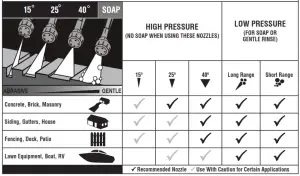
USING THE HIGH-PRESSURE HOSE
 WARNING:
WARNING:
Injection hazard. Fully unwrap and straighten high-pressure hose prior to and during each use and do not allow it to become kinked. The high-pressure hose features an outer covering that provides strength to the hose. If the outer covering becomes damaged, stop using the hose and replace it immediately. A kinked or damaged hose can develop a high-pressure leak and result in a possible injection or another serious personal injury.
To prevent damage to the outer covering:
- Inspect the hose before every use.
- Fully unwrap and straighten the hose before use.
- Do not allow the high-pressure hose to be kinked.
- Keep the hose away from hot surfaces and sharp edges.
- Do not pull the unit by high-pressure hose.
- Do not allow those to be crushed or wrapped around objects.
WASHING WITH DETERGENT
See Figures 14 – 16.
As sold, this unit is designed for use with “downstream” pressure washer detergents.
To convert for use with “upstream” detergents, contact customer service or a qualified service center for
more information.
NOTICE:
USE ONLY DETERGENTS DESIGNED FOR PRESSURE
WASHERS. Do not use household detergents, acids, alkalines, bleaches, solvents, flammable material, or
industrial-grade solutions, which can damage the pump or cause property damage. Many detergents may require mixing prior to use. Prepare cleaning solution as instructed on the solution bottle. Always test in an inconspicuous area before beginning.
- Remove the cap from the soap tank and pour pressure washer detergent into the tank. Replace the cap on the tank.
NOTE: The machine setting of this unit is 20:1, which usually allows the use of 1-gallon pressure washer detergent without further dilution. Check your detergent instructions to be sure additional dilution is not necessary. - Install 5-in-1 Change-over Nozzle (if necessary). Rotate the spray selector on the nozzle to either the blue short-range detergent (
 ) or blue long-range detergent (
) or blue long-range detergent ( ) setting.
) setting. - Squeeze the trigger and wait approximately 5 seconds for the detergent to appear.
- Spray the detergent on a dry surface using long, even, overlapping strokes. To prevent streaking, do not allow detergent to dry on the surface.
For long-range detergent application:
With the nozzle installed on the spray wand and the engine shut off, rotate the spray selector to the long-range detergent [![]() ] setting.
] setting.
For short-range detergent application:
With the nozzle installed on the spray wand and the engine shut off, rotate the spray selector to the short-range detergent [![]() ] setting.
] setting.
Before shutting off the engine:
- Fill the soap tank with clean water.
- Spray the clear water through the spray wand until the tank is empty.
- If any detergent remains in the spray, repeat with the second tank of clean water.
- Shut off the engine.
NOTE: Shutting off the engine will not relieve pressure in the system. Pull the trigger to release water pressure.
RINSING WITH THE PRESSURE WASHER
- Turn off the pressure washer and shut off the water supply. Pull the trigger to release water pressure.
- Engage the lockout on the trigger handle by pushing up on the lockout until it clicks into the slot.
- Select the right nozzle setting for the job. See the chart shown earlier in the manual to select the appropriate nozzle setting.
- When using these settings, test a small area first to avoid surface damage.
- Start at the top of the area to be rinsed and work down, overlapping the strokes.
USING PUMP PROTECTOR
Regular use of a commercially available pump protector prolongs the life of the pressure washer by removing hard water mineral deposits, lubricating pump seals and pistons, and preventing freeze damage. A pump protector should be added to the unit after every use and before storage. Pump protector can be purchased at the retailer where you purchased your pressure washer, or by calling customer service.
The instructions that follow are typical for adding a pump protector but you should always verify the specific instructions provided by the manufacturer of the pump protector used.
- Turn off the pressure washer engine and shut off the water supply. Pull the trigger to release water pressure.
- Disconnect the garden hose and high-pressure hose.
- Unscrew the threaded top from the pump protector bottle and remove the paper seal from the bottle. Reinstall the top on the bottle and tighten securely.
NOTE: The rubber seal should remain inside the threaded top. If it comes out, be sure to replace it before reinstalling the top. - Remove bottle cap and attach the threaded end of the bottle securely to pressure washer pump water intake.
- Squeeze the bottle to inject contents into the pump.
- With engine switch off, pull starter grip and rope to cycle pump, then squeeze bottle again to guarantee complete coverage.
- The pump is protected when the protector fluid exits the pump outlet.
MOVING THE PRESSURE WASHER
NOTE: Never lift or carry this product using the handle and never place the unit in any position other than upright on its wheels.
- Turn the pressure washer off.
- Pull the handle up until the handle release knob snaps into the locking position (if not already up and locked). Ensure the lock is secured in the frame hole before moving.
- Tilt the machine toward you slightly until it balances on the wheels then roll the machine to the desired position.
Do not tilt forward or sideways when moving. - DO NOT attempt to move the unit by pulling on any of the hoses.
MAINTENANCE
Normal maintenance, replacement, or repair of emission control devices and systems may be performed by any qualified repair establishment or individual with original or equivalent parts. Warranty and recall repairs must be performed by an authorized service center; please contact customer service for assistance.
 WARNING:
WARNING:
Before inspecting, cleaning, or servicing the machine, shut off the engine, wait for all moving parts to stop, and disconnect the spark plug wire and move it away from the spark plug. Allow 30 minutes of cool-down time before performing any maintenance. Failure to follow these instructions can result in serious personal injury or
property damage.
 WARNING:
WARNING:
Always wear eye protection with side shields marked to comply with ANSI Z87.1. Failure to do so could result in objects being thrown into your eyes resulting in possible serious injury.
 WARNING:
WARNING:
When servicing, use only recommended or equivalent replacement parts. Use of any other parts could create
a hazard or cause product damage.
NOTICE:
This product is not equipped with a spark arrestor and cannot be used on U.S. forest lands; in addition, the product users must comply with Federal, State, and local fire prevention regulations. Check with appropriate authorities. Refer to the accompanying engine manual for maintenance and replacement parts.
NOTICE:
Periodically inspect the entire product for damaged, missing, or loose parts such as screws, nuts, bolts, caps, etc. Tighten securely all fasteners and caps and do not operate this product until all missing or damaged parts are replaced. Please contact customer service or a qualified service center for assistance.
GENERAL MAINTENANCE
Avoid using solvents when cleaning plastic parts. Most plastics are susceptible to damage from various types of
commercial solvents and may be damaged by their use. Use clean cloths to remove dirt, dust, lubricant, grease, etc.
 WARNING:
WARNING:
Do not at any time let brake fluids, gasoline, petroleum-based products, penetrating lubricants, etc., come in contact with plastic parts. Chemicals can damage, weaken or destroy plastic which could result in serious personal injury.
Before running the engine, perform the following pre-operation steps:
- Check that all bolts, nuts, etc., are securely tightened.
- Make sure the air filter is clean.
- Check both the engine lubricant level and the fuel tank level; refill as needed.
- Inspect the work area for hazards.
- If there is excessive noise or vibration, stop the unit immediately.
NOZZLE MAINTENANCE
Excessive pump pressure (a pulsing sensation felt while squeezing the trigger) may be the result of a clogged or
dirty nozzle.
- Turn off the pressure washer and shut off the water supply.
Pull the trigger to release water pressure. - Remove the nozzle from the spray wand.
 WARNING:
WARNING:
NEVER remove nozzles without first turning off the engine, relieving the water pressure in the trigger handle, and locking the lockout on the trigger handle. NEVER point the nozzle at your face or at others. The quick-connect feature contains small springs that could eject the nozzle with some force. Failure to follow these
instructions could result in an eye injury or other serious personal injury.
- Using a straightened paper clip or fine needle (not included), free any foreign materials clogging or
restricting the nozzle. - Using a garden hose, flush debris out of the nozzle by backflushing (running the water through the nozzle backward or from the outside to the inside).
- Reconnect the nozzle to the spray wand.
- Turn on the water supply and start the engine.
PUMP LUBRICATION
The pump on this product was lubricated with a sufficient amount of high-grade lubricant for the life of the unit under normal operating conditions. Therefore, no further lubrication is required.
PUMP MAINTENANCE
Routinely make a visual inspection of the pump. If you notice any leaking of lubricant around the pump seals, take the pressure washer to a qualified service center for repair. There are no user-serviceable parts to the pressure washer pump. Any attempt to service or alter the pump may damage the pressure washer and void your product warranty.
STORING THE PRESSURE WASHER
NOTE: Regular use of fuel stabilizer and pump protector will give you better performance of the unit and increase the life of the pump.
WARNING:
While storing, keep at least 3 feet of clearance on all sides of this product, including overhead. Allow a minimum of 30 minutes of “cool down” time before storage. The heat created by muffler and exhaust gases could be hot enough to ignite combustible objects. Store in a dry, covered area where the weather can’t damage it. It is important to store this product in a frost-free area. Always empty water from all hoses, the pump, and the soap tank before storing.
- Drain the fuel tank completely by running the pressure washer until the gas runs out. Stored gas can go stale in 30 days.
NOTE: Make sure the water supply is connected and turned on when allowing the pressure washer engine to run. - Make sure the on/off switch is in the OFF position.
- Disconnect both the high-pressure hose and the garden hose from the pump.
- Empty the pump by pulling on the starter grip and rope about 6 times. This should remove most of the liquid from the pump.
NOTICE:
If the location where your pressure washer is stored will fall below 32°F, the use of a pump protector is required before storing to prevent freeze damage. Freeze damage will void your warranty.
- Drain the lubricant and replace it with fresh, clean lubricant as described in Changing Engine Lubricant earlier in this manual.
- Disconnect the spark plug wire and remove the spark plug. Pour about a teaspoon of clean, air-cooled, four-cycle lubricant through the spark plug hole into the combustion chamber.
- Leaving the spark plug out, pull the starter cord two or three times to coat the inside of the cylinder wall.
- Inspect the spark plug and clean or replace, as necessary.
- Reinstall the spark plug, but leave the spark plug wire disconnected.
- Clean the air filter.
- Extend the starter grip and rope to check its condition. If the rope is frayed, have it replaced immediately by a qualified service center.
- Remove all hoses. Coil the hoses and store as shown. Do not allow the hose to become kinked.
- Pull the handle release knob out and lower the handle to the down position.
- Store the unit and accessories in an area that does not reach freezing temperatures. Do not store near furnaces or other sources of heat that could dry out the pump seals.
PREPARING FOR USE AFTER STORAGE
- Pull the starter grip and rope three or four times to clean lubricant from the combustion chamber.
- Remove spark plug from the cylinder. Wipe lubricant from the spark plug and return it to the cylinder.
- Reconnect the spark plug wire.
- Refuel the machine as described earlier in the operator’s manual.
PERIODIC MAINTENANCE SCHEDULE TABLE
NOTE: If a separate engine manual is provided for this pressure washer, please follow the maintenance schedule provided in the engine manual instead of the maintenance information listed below.
| Maintenance Items | Each use | Weekly | 5 hrs | 25 hrs | 50 hrs | 200 hrs |
| Check for water leaks under the manifold, into the crankcase | X | |||||
| Plumbing | X | |||||
| Clean engine and check nuts and bolts | X | |||||
| Check and refill engine lubricant | X | |||||
| Check water inlet filter placement2 | X | |||||
| Add fuel stabilizer | X | |||||
| Add pump protector | X | |||||
| Change engine lubricant1 | X | X | ||||
| Check spark plug | X | |||||
| Clean air filter | X | |||||
| Replace air filter element | X | |||||
| Clean and adjust spark plug and electrodes | X | |||||
| Replace spark plug | X |
1 Initial lubricant change should be performed after the first 5 hours of operation. Thereafter, change lubricant every 50 hours.
2 If the water inlet filter is missing or damaged, it must be replaced. See Replacement Parts List available online or call customer service for the part number to order.
NOTE: If you are not sure how to perform any of the maintenance items listed above, take the unit to a qualified service center to have the maintenance item performed.
| PROBLEM | POSSIBLE CAUSE | SOLUTION |
| Engine fails to start | No fuel in the tank Water pressure in hose Spark plug shorted or fouled Spark plug is broken (cracked porcelain or electrodes broken) Ignition lead wire shorted, broken or disconnected from spark plug Ignition inoperative |
Fill tank Squeeze trigger to relieve water pressure Replace spark plug Replace spark plug Replace lead wire or attach to spark plug Contact a qualified service center |
| Engine hard to start | Water in gasoline Weak spark at the spark plug |
Drain entire system and refill with fresh fuel Contact a qualified service center |
| Engine lacks power | Dirty air filter Air in the line causing the idle down feature to perform incorrectly |
Clean or replace the air filter With the engine off, squeeze the trigger until water comes out to remove air from the line. |
| Detergent fails to mix with a spray | Spray selector on the 5-in-1 Change-over Nozzle is set to either the 40º, 25º, or 15º setting Soap tank is empty |
Rotate the spray selector on the 5-in-1 Change-over Nozzle to either the short-range detergent [ Add detergent to soap tank |
| The pump doesn’t produce pressure | The spray selector on the 5-in-1 Change-over Nozzle is set to either the short-range detergent [ Inadequate water supply Trigger handle or spray wand leaks Nozzle is clogged Air inline Hose is leaking Kink in hose Pump is faulty |
Rotate the spray selector on the 5-in-1 Change- over Nozzle to either the 40º, 25º, or 15º setting Provide adequate water flow Check connections and/or replace trigger handle or spray wand Clean nozzle Squeeze the trigger on the trigger handle to remove air from line Replace hose Eliminate kinks in the hose Contact a qualified service center |
| Machine doesn’t reach high pressure | The diameter of the garden hose is too small Water supply is restricted Not enough inlet water Spray selector on the 5-in-1 Change-over Nozzle is set to either the short-range detergent [ |
Replace with 3/4 in. garden hose Check the garden hose for kinks, leaks, and blockages Open water source full force Rotate the spray selector on the 5-in-1 Change- over Nozzle to either the 40º, 25º, or 15º setting |
If the problem persists after trying the above solutions, contact customer service or a qualified service center for assistance.
NOTICE: As the equipment owner, you are responsible for the performance of the required maintenance listed in the Maintenance section. It is recommended that you retain all receipts covering maintenance on your equipment. Neglecting or failing to perform the required maintenance may increase emissions, decrease fuel efficiency, degrade performance, cause irreversible engine damage, and/or void your warranty.
OPERATOR’S MANUAL
3300 PSI PRESSURE WASHER
• PARTS AND SERVICE: Prior to requesting service or purchasing replacement parts, please obtain your item, manufacturing, and serial numbers from the product data plate.
ITEM NO.* ________________MANUFACTURING NO.
SERIAL NO. ________________
* Model/item number on a product may have additional letters at the end. These letters designate manufacturing information and should be provided when calling for service.
HOW TO OBTAIN REPLACEMENT PARTS:
Replacement parts can be purchased online at www.ryobitools.com or by calling
1-800-525-2579. Replacement parts can also be obtained at one of our service centers.
HOW TO LOCATE A SERVICE CENTER:
Service centers can be located online at www.ryobitools.com or by calling 1-800-525-2579.
HOW TO OBTAIN CUSTOMER OR TECHNICAL SUPPORT:
To obtain customer or technical support please contact us at 1-800-525-2579.
RYOBI is a trademark of Ryobi Limited and is used pursuant to a license granted by Ryobi Limited.
TECHTRONIC INDUSTRIES POWER EQUIPMENT
P.O. Box 1288, Anderson, SC 29622, USA
1-800-525-2579 • www.ryobitools.com
